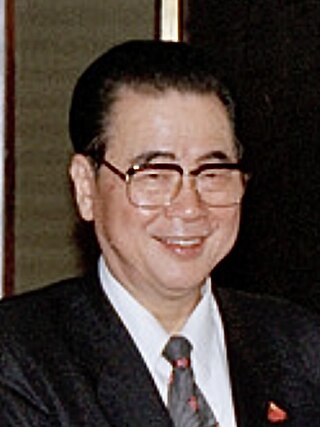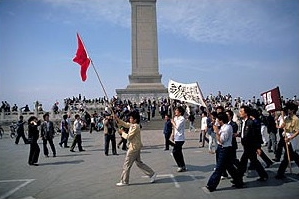
Deng Xiaoping was a Chinese revolutionary and statesman who served as the paramount leader of the People's Republic of China (PRC) from December 1978 to November 1989. After Chinese Communist Party chairman Mao Zedong's death in 1976, Deng rose to power and led China through its process of Reform and Opening Up and the development of the country's socialist market economy. Deng developed a reputation as the "Architect of Modern China" and his ideological contributions to socialism with Chinese characteristics are described as Deng Xiaoping Theory.

Mao Zedong, also known as Chairman Mao, was a Chinese politician, Marxist theorist, military strategist, poet, and revolutionary who was the founder of the People's Republic of China (PRC). He led the country from its establishment in 1949 until his death in 1976, while also serving as the chairman of the Chinese Communist Party during that time. His theories, military strategies and policies are known as Maoism.

Li Peng was a Chinese politician who served as the fourth Premier of the People's Republic of China from 1987 to 1998, and as the Chairman of the Standing Committee of the National People's Congress, China's top legislative body, from 1998 to 2003. For much of the 1990s Li was ranked second in the Chinese Communist Party (CCP) hierarchy behind then Party General Secretary Jiang Zemin. He retained his seat on the CCP Politburo Standing Committee until his retirement in 2002.

The Tiananmen Square protests, known in China as the June Fourth Incident, were student-led demonstrations held in Tiananmen Square, Beijing, China, lasting from 15 April to 4 June 1989. After weeks of unsuccessful attempts between the demonstrators and the Chinese government to find a peaceful resolution, the Chinese government declared martial law on the night of 3 June and deployed troops to occupy the square in what is referred to as the Tiananmen Square massacre. The events are sometimes called the '89 Democracy Movement, the Tiananmen Square Incident, or the Tiananmen uprising.

Hu Yaobang was a Chinese politician who was a high-ranking official of the People's Republic of China. He held the top office of the Chinese Communist Party (CCP) from 1981 to 1987, first as Chairman from 1981 to 1982, then as General Secretary from 1982 to 1987. After the Cultural Revolution (1966–1976), Hu rose to prominence as a close ally of Deng Xiaoping, the paramount leader of China at the time.

Zhao Ziyang was a Chinese politician. He was the third premier of the People's Republic of China from 1980 to 1987, vice chairman of the Chinese Communist Party (CCP) from 1981 to 1982, and CCP general secretary from 1987 to 1989. He was in charge of the political reforms in China from 1986, but lost power for his support of the 1989 Tian'anmen Square protests.

Yang Shangkun was a Chinese Communist military and political leader, president of the People's Republic of China from 1988 to 1993, and one of the Eight Elders that dominated the party after the death of Mao Zedong.

Fang Lizhi was a Chinese astrophysicist, vice-president of the University of Science and Technology of China, and activist whose liberal ideas inspired the pro-democracy student movement of 1986–87 and, finally, the Tiananmen Square protests of 1989. Because of his activism, he was expelled from the Chinese Communist Party in January 1987. For his work, Fang was a recipient of the Robert F Kennedy Human Rights Award in 1989, given each year. He was elected an academician of the Chinese Academy of Sciences in 1980, but his position was revoked after 1989.

The time period in China from the death of Mao Zedong in 1976 until the 1989 Tiananmen Square protests and massacre is often known as Dengist China. In September 1976, after Chairman Mao Zedong's death, the People's Republic of China was left with no central authority figure, either symbolically or administratively. The Gang of Four was purged, but new Chairman Hua Guofeng insisted on continuing Maoist policies. After a bloodless power struggle, Deng Xiaoping came to the helm to reform the Chinese economy and government institutions in their entirety. Deng, however, was conservative with regard to wide-ranging political reform, and along with the combination of unforeseen problems that resulted from the economic reform policies, the country underwent another political crisis, culminating in the crackdown of massive pro-democracy protests in Tiananmen Square.
Liu Binyan was a Chinese author, journalist, and political dissident.

Wan Li was a Chinese Communist revolutionary and politician. During a long administrative career in the People's Republic of China, he served successively as Vice Premier, Chairman of the Standing Committee of the National People's Congress (NPC), and a member of the Chinese Communist Party (CCP) Secretariat and its Politburo. Wan joined the Chinese Communist Party in 1936 and led revolutionary and wartime resistance activities in his native Shandong province. After the founding of the communist state in 1949, Wan served in a series of government ministries, then worked as a member of the municipal leadership in Beijing. He was purged during the Cultural Revolution, but was eventually rehabilitated and returned to work as party chief of Anhui province, where he led the implementation of successful agrarian reforms centered on the household-responsibility system. In the 1980s, Wan became one of the leading moderate reformers in China's top leadership, advocating for constitutional reforms, the strengthening of legislative institutions, and the abolition of 'lifelong-terms' of top political leaders. He was named head of the national legislature in 1988. He retired in 1993.
Wang Ruowang was a Chinese author and dissident who was imprisoned various times for political reasons by both the Kuomintang and the Communist government of China for advocating reform and liberalization. His name at birth was "Shouhua", but he was most commonly known by his pen name, "Ruowang". He was a prolific essayist and literary critic.

Bao Tong was a Chinese writer and activist. He was Director of the Office of Political Reform of the Central Committee of the Chinese Communist Party (CCP) and the Policy Secretary of Zhao Ziyang. He was also Director of the Drafting Committee for the CCP 13th Party Congresses, known for its strong support of market reform and opening up under Deng Xiaoping. Prior to this, he was a committee member and then deputy director of the Chinese State Commission for Economic Reform. During the 1989 Tian’anmen square protests, he was one of the very few Chinese senior officials to express understandings with the demonstrating students, which led to his arrest shortly before the June Fourth incident.
Anarchism in China was a strong intellectual force in the reform and revolutionary movements in the early 20th century. In the years before and just after the overthrow of the Qing dynasty Chinese anarchists insisted that a true revolution could not be political, replacing one government with another, but had to overthrow traditional culture and create new social practices, especially in the family. "Anarchism" was translated into Chinese as 無政府主義 literally, "the doctrine of no government."
The April 26 Editorial was a front-page article published in People's Daily on April 26, 1989, during the Tiananmen Square protests. The editorial effectively defined the student movement as a destabilizing anti-party revolt that should be resolutely opposed at all levels of society. As the first authoritative document from the top leadership on the growing movement, it was widely interpreted as having communicated the party's zero-tolerance position to student protesters and their sympathizers.
Richard Dennis Baum was an American China watcher, professor emeritus of political science at UCLA, and former director emeritus of the UCLA Center for Chinese Studies, noted for his many academic works on Chinese politics. Baum credited Rhoda Sutherland of Oxford University with inspiring his interest in linguistics.
The April 27 demonstrations were massive student protest marches throughout major cities in China during the 1989 Tiananmen Square protests. The students were protesting in response to the April 26 Editorial published by the People's Daily the previous day. The editorial asserted that the student movement was anti-party and contributed to a sense of chaos and destabilization. The content of the editorial incited the largest student protest of the movement thus far in Beijing: 50,000–200,000 students marched through the streets of Beijing before finally breaking through police lines into Tiananmen Square.

The Baise Uprising was a short-lived uprising organized by the Chinese Communist Party (CCP) in northwestern Guangxi around the city of Baise. It officially began on December 11, 1929, and lasted until late 1931. The uprising established the Seventh Red Army and a soviet over a number of counties in the You River valley. It drew support from a pre-existing movement of Zhuang peasants led by Wei Baqun, and focused on land redistribution in the area it controlled. After a brief but costly attempt to capture Guangxi's major cities, the soviet was suppressed and surviving soldiers made their way to Jiangxi. Today, it is most famous for the role played by Deng Xiaoping, who was the CCP Central Committee's leading representative in Guangxi during the Uprising. Deng was strongly criticized, both during the Cultural Revolution and by modern historians, for the uprising's swift defeat and his decision to abandon the retreating Seventh Red Army.
The protests that occurred throughout the People's Republic of China in the early to middle months of 1989 mainly started out as memorials for former General Secretary Hu Yaobang. The political fall of Hu came immediately following the 1986 Chinese Student Demonstrations when he was removed by paramount leader Deng Xiaoping for being too liberal in his policies. Upon Hu's death on April 15, 1989, large gatherings of people began forming across the country. Most media attention was put onto the Beijing citizens who participated in the Tiananmen Square Protests, however, every other region in China had cities with similar demonstrations. The origins of these movements gradually became forgotten in some places and some regions began to demonstrate based on their own problems with their Provincial and Central Governments.

Anti-bourgeois liberalization as a political slogan of the Chinese Communist Party (CCP), it was proposed by Deng Xiaoping and others in the early 1980s. As a political movement against "bourgeois liberalization", it started at the CCP Congress held in Beijing in September 1986. The Sixth Plenary Session of the Twelfth Central Committee of the CCP was officially launched in early 1987.













